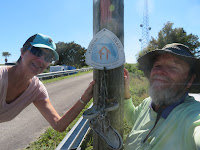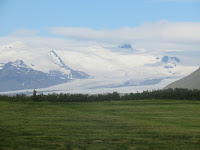 When in Dunedin we had
been a 20-minute drive from where our good friends, Bill and Randy Horn winter.
Sadly, they hadn’t arrived for the winter yet. Luckily, they arrived a few days
before we left Fort Pierce, so we set out on the 3-hour (one way) drive to
Venice Florida. With a population of a little over 20,000, and being on the
Gulf Coast, the town has the amenities to make living there comfortable, but is
small enough not to get completely overrun. The home is ideal – it has a pool
and hot tub in the screened in courtyard – and perfectly situated. We walked to
the quaint downtown for a great lunch, then to the beach, always under the
cover of trees keeping the hot Florida sun at bay. Made us think a bit!
When in Dunedin we had
been a 20-minute drive from where our good friends, Bill and Randy Horn winter.
Sadly, they hadn’t arrived for the winter yet. Luckily, they arrived a few days
before we left Fort Pierce, so we set out on the 3-hour (one way) drive to
Venice Florida. With a population of a little over 20,000, and being on the
Gulf Coast, the town has the amenities to make living there comfortable, but is
small enough not to get completely overrun. The home is ideal – it has a pool
and hot tub in the screened in courtyard – and perfectly situated. We walked to
the quaint downtown for a great lunch, then to the beach, always under the
cover of trees keeping the hot Florida sun at bay. Made us think a bit! We got a chance for a
bonus as well. It turns out that Florida is lucky enough to have two Whispering
Giant sculptures. One is in Fort Lauderdale and is still on our list. The
other, Calostimucu, is at the Chamber of Commerce building in Punta Gorda.
While checking it out added about an hour to our trip, it turned out to be well
worth it. We learned that Calostimucu is the only one that Peter Wolf Toth
decided to carve a face on both sides of the statue.
We got a chance for a
bonus as well. It turns out that Florida is lucky enough to have two Whispering
Giant sculptures. One is in Fort Lauderdale and is still on our list. The
other, Calostimucu, is at the Chamber of Commerce building in Punta Gorda.
While checking it out added about an hour to our trip, it turned out to be well
worth it. We learned that Calostimucu is the only one that Peter Wolf Toth
decided to carve a face on both sides of the statue. Happy Thanksgiving to
all. We are celebrating here in Fort Pierce on our last full day in town. Tomorrow
we will be heading north to Flagler Beach where we will spend a couple of
months. We sure hope there is a lot to do there!
Happy Thanksgiving to
all. We are celebrating here in Fort Pierce on our last full day in town. Tomorrow
we will be heading north to Flagler Beach where we will spend a couple of
months. We sure hope there is a lot to do there!
Talk to you soon.






















































